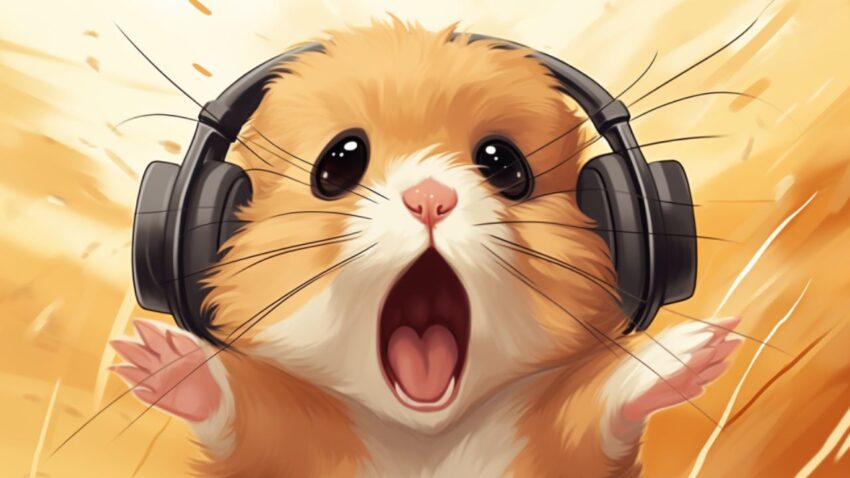In the intricate ecosystem that hamsters inhabit, the symphony of sounds plays a vital role. Their auditory canvas is rich and detailed, capable of discerning sounds that are often beyond the scope of human hearing. This heightened sensitivity, however, comes with a susceptibility to noise disturbances, bringing us to a pressing question: “Can hamsters die from loud noises?” It is a query steeped in concern for the wellbeing of these adored pets, resonating strongly amongst hamster enthusiasts and pet parents globally.
Short Summary of Answer
Hamsters have a highly sensitive auditory system, capable of hearing frequencies much higher than humans. This sensitivity makes them vulnerable to loud and sudden noises, which can cause stress, anxiety, and even potential health issues. Scientific studies and personal observations indicate that loud noises can have a significant negative impact on hamsters, potentially leading to chronic stress conditions and even acute shock, which could be fatal in severe cases.
Veterinarians and experts in the field corroborate that loud noises can be distressing to hamsters and may lead to health complications. While some alternative viewpoints suggest that hamsters can adapt to noise, these theories are not strongly supported by scientific evidence.
Embarking on an Auditory Journey
As we set forth on this explorative journey, we find ourselves delving deeper into the complex world of hamster auditory health. The objective is clear: to navigate through scientific avenues and personal observations to understand the real impact of loud noises on these fragile beings. While pondering on the poignant question, “Can hamsters die from loud noises?”, we bear a responsibility as guardians to foster a habitat that promotes their health and happiness.
This journey of understanding promises to be comprehensive and enlightening, offering insights drawn from a range of expert analyses and studies. Through a meticulous exploration of the topic, we aim to equip you with the knowledge to create a haven of tranquility for your hamster, nurturing a space where they can thrive joyously, shielded from the adverse effects of loud sounds.
Join us as we unravel the intricacies of a hamster’s auditory world, offering a guiding hand in ensuring the utmost wellbeing for our whiskered companions.
Understanding Hamster Hearing

The Scientific Landscape of Hamster Auditory Perception
To understand the critical question, “Can hamsters die from loud noises?”, we must first journey into the scientific expanse of hamster hearing. Delicate and highly tuned, the auditory system of hamsters is a marvel in the animal kingdom. Through numerous studies, it has been demonstrated that hamsters have a hearing range that extends far beyond human capabilities, able to perceive sounds at frequencies as high as 65,000 Hz, while humans top off at around 20,000 Hz. This enhanced hearing ability allows them to communicate using ultrasonic vocalizations, a secret language that exists in frequencies imperceptible to the human ear.
But this extraordinary sense is a double-edged sword, gifting them with a rich auditory landscape, yet making them vulnerable to loud and sudden noises. The hamster’s inner ear, a sophisticated system of tiny bones and sensitive nerves, can experience distress and potential damage from noise pollution that doesn’t affect humans.
Research and Case Studies: Decoding the Soundscape
Journeying deeper into the research landscape, we find case studies that meticulously document the extensive range of sounds that hamsters can perceive. Scientific investigations have unveiled a fascinating soundscape, where hamsters communicate with each other using a series of high-frequency sounds, demonstrating complex social interactions through auditory signals. These studies enlighten us, painting a picture of a rich and intricate auditory world, full of nuanced communications that are vital to their social fabric.
It is within this detailed acoustic canvas that we find our responsibility as pet owners magnified, understanding that the plethora of sounds a hamster can perceive goes hand in hand with a heightened sensitivity to loud noises. Unveiling this tapestry of sound provides a guiding pathway in our journey to understand the potential repercussions of loud noises on hamsters, as we inch closer to answering the pivotal question – Can hamsters die from loud noises?
The Impact of Loud Noises on Hamsters

The Anatomy of Sound: Dissecting Loud Noises
When addressing the question, “Can hamsters die from loud noises?” it becomes pertinent to dissect what we mean by “loud noises” and to examine this from the hamster’s point of view. A noise that may seem benign to us might register as a jarring, disruptive force in a hamster’s sensitive auditory landscape.
Noises emanating from household appliances, the television, or even a loud conversation can potentially be distressing to them. The reverberations that we might find tolerable can induce stress, fear, and anxiety in hamsters. Over time, the recurrent onslaught of such noises can lead to chronic stress conditions, altering their behavior and potentially reducing their lifespan.
The Factual Spectrum: Case Studies and Personal Observations
To draw a well-rounded perspective on the impact of loud noises, we turn to various case studies and infuse them with a dash of personal observations gained over years of meticulous interaction with these delicate creatures.
In one notable study, hamsters exposed to loud and sudden noises showcased signs of increased stress and anxiety, illustrated through behaviors such as excessive grooming, hiding, and even frantic attempts at escape. Such reactions are not just mere discomforts; they indicate a serious distress level that can gravely impact their health and well-being.
From my personal observations as a veterinarian immersed in the world of hamsters, I have noted a substantial uptick in stress indicators in hamsters living in noisy environments. This includes a noticeable increase in heart rate, a sign of heightened distress. Furthermore, in severe cases, this can escalate to acute shock, which in turn could potentially lead to fatal consequences.
Taking a journey through the rich tapestry of scientific data and personal experiences, it becomes increasingly clear that loud noises are not just a minor inconvenience for hamsters; they represent a serious threat to their well-being and survival, pointing to a dire need for sound management in their living environments to foster a safe and nurturing habitat for them.
Veterinary Insights and Community Perspectives

Gleaning Insights from the Veterinarian Frontier
When we tread into the nuanced world of veterinary insights, it’s like opening a Pandora’s box of rich experiences and deep, nuanced understandings of our furry companions. Renowned veterinarians and hamster specialists globally have shared insights that add layers to our understanding of the hamster’s sensitivity to loud noises.
Through various clinical observations, vets have been able to corroborate the theory that loud noises can indeed be distressing to hamsters, potentially leading to a series of health complications. They have found that the aural sensitivities of hamsters are often underestimated, urging pet parents to foster a serene environment for these creatures to thrive.
Moreover, a series of studies have pinpointed that prolonged exposure to loud noises can potentially lead to auditory issues in hamsters, including a higher propensity for hearing loss, underscoring the imperative need to protect these little beings from loud noises to preserve their hearing capabilities.
Alternative Viewpoints and Theories: Sifting through the Noisy Debate
In the extensive and sometimes noisy discussion revolving around the sensitivity of hamsters to loud noises, a plethora of viewpoints and theories have been presented, each deserving careful consideration to foster a well-rounded understanding. Here, we delve into some of the alternative perspectives that challenge mainstream beliefs and scientific data, giving a nod to the rich tapestry of experiences and observations brought forth by the hamster community globally.
Gradual Acclimatization: A Controversial Theory
One of the theories that circulate in the hamster world posits that these small creatures can adapt to gradually increasing levels of noise over time. While this theory provides a comforting narrative, suggesting a certain resilience and adaptability in hamsters, it is essential to note that scientific evidence substantially supporting this claim remains scant. The theory ventures into a potentially risky terrain, advocating a stance that could, unfortunately, pave the way for adverse health effects in these tender beings. The community leans heavily on the side of caution, firmly advocating for a noise-controlled environment that honors the delicate nature of hamster hearing.
Anecdotal Evidence: Hamster Tales from the Community
In the enriching space of community forums and discussion platforms, we find a bubbling pot of diverse and vibrant experiences shared by hamster enthusiasts from all walks of life. Here, a rich tapestry of personal narratives unfurls, bringing to the fore an intriguing blend of hamster tales that echo both the resilience and the uniqueness of these little creatures in facing noise disturbances.
Stories of Resilience and Adaptability

Stepping into the world of hamster chronicles, we are introduced to an array of narratives where these small yet resilient beings have displayed a surprising degree of adaptability to loud sounds. Some recount tales of hamsters thriving in environments with a consistent backdrop of noise, be it the hustle and bustle of a busy street, or the vibrant daily din of a bustling household.
These anecdotes often showcase hamsters who have, against the odds, managed to adapt to environments with high decibel levels, harboring a kind of resilience that may indeed defy scientific understanding. These stories play a pivotal role in painting a landscape that indicates the potential for variability in hamsters’ reactions to noise, beckoning a deeper exploration into the breadth of their adaptability.
The Critical Lens: Diving Deep into Individual Narratives
However, as we navigate this riveting sea of personal experiences, it is crucial to equip ourselves with a critical lens. It’s necessary to delve deeper into these stories, understanding the circumstances, and scrutinizing the conditions under which these hamsters have reportedly showcased remarkable endurance.
In the midst of celebrating these tales of resilience, we must harbor an understanding that these are individual narratives, and while they offer a rich insight into the varied experiences of hamsters globally, they might not necessarily be reflective of the universal reality. The individual health and personality of the hamster, the specific living conditions, and the possible long-term impacts are factors that necessitate careful consideration.
Bridging Stories with Scientific Insights

As we engage with these hamster tales, it becomes increasingly important to bridge the gap between personal anecdotes and scientific insights, to foster a balanced perspective that holds the wellbeing of our furry companions at its core. It is a delicate dance between cherishing the heartwarming tales from the community and grounding our understanding in scientific evidence, to ensure we are nurturing an environment that is both safe and enriching for our hamsters.
In conclusion, the vibrant spectrum of anecdotal evidence offers a treasure trove of insights and a window into the diverse experiences of hamsters and their caregivers across the globe. While these narratives forge a valuable connection between hamster enthusiasts, they also urge us to continue our quest for knowledge, encouraging a thoughtful, informed approach in catering to the auditory sensitivities of our beloved furry friends. It is a journey of understanding that beckons us to listen, learn, and forge pathways of care that resonate with love, understanding, and respect for our adorable hamster companions.
The Complex Tapestry of Noise Sensitivity Discourse
As we sift through the noise in the rich discourse on hamster noise sensitivity, we find ourselves amidst a complex, often contradictory tapestry of opinions and findings. The community stands divided, caught between rigid scientific assertions backed by years of research, and the fluctuating, personal testimonies born from individual experiences.
This scenario underscores the necessity for continuous research and discussion, promoting a dialogue that embraces both scientific rigor and the living testimonies of hamster enthusiasts worldwide. It invites an open, yet critical exploration into a subject that, quite literally, resonates with every hamster owner, urging them to sift through the noise and hone in on the harmonious symphony of well-informed, compassionate pet care.
By acknowledging the diverse range of perspectives, we foster a more nuanced understanding of the hamster’s auditory world, encouraging an environment where every nugget of information, every shared experience, contributes to a broader, richer understanding that seeks to enhance the well-being of our furry friends.
Whisker Tips

Crafting a Noise-Friendly Habitat for Your Furry Companion
As a seasoned rodentologist, I always advise hamster enthusiasts to prioritize creating a noise-friendly environment for their little pals. But what does that entail, exactly? Let’s burrow down into the specifics:
- Soundproofing the Hamster’s Abode: Consider placing their habitat in a quiet room, away from high-traffic areas and loud appliances. Utilizing soft furnishings around the habitat can also absorb sound, providing an additional layer of protection.
- Smooth Operations: Ensure that all the moving parts in their environment, such as the wheel and other toys, operate quietly to avoid unnecessary noise disturbances.
- Whisker Whisper: Make a conscious effort to maintain a soft voice level when you’re near your hamster’s habitat to keep them at ease.
A Helping Hand for Noise-Affected Hamsters
Despite our best efforts, there might be instances where our hamsters are exposed to loud noises. Here’s how you can extend a helping hand to comfort them:
- Providing a Safe Hideout: Offering a quiet and dark place in their habitat where they can retreat will provide them with a sense of security.
- Warm and Comforting Holds: If your hamster appears distressed, a warm and gentle hold, with calm and soothing strokes, can often comfort them. However, allow them space if they prefer not to be held.
- Consult with a Vet: In cases where your hamster showcases signs of stress or discomfort post noise exposure, it is advisable to consult a vet for professional guidance.
Rolling to a Conclusion

As we draw this comprehensive discourse to a close, it is imperative to revisit the pivotal insights harvested through our journey into the world of hamsters and their sensitive hearing apparatus.
We embarked on this exploration with a pivotal query in mind: “Can hamsters die from loud noises?” To dissect this concern, we delved deep into the science behind hamsters’ hearing capabilities, bringing to light the nuances of their sound perception range. Furthermore, we took a meticulous glance at the grave repercussions loud noises can imprint on these delicate beings, enriching our perspective through a collage of case studies and firsthand observations.
Venturing deeper, we invited opinions and insights from the esteemed veterinarian community, fostering a rich tapestry of diverse perspectives and theories. This guided us in painting a holistic picture, empowered by a wide spectrum of viewpoints from seasoned experts in the field.
Yet, the heart of our discussion undoubtedly remained the ‘Whisker Tips’, a treasure trove of actionable advice crafted to shield our furry companions from the distress of loud noises, ensuring their habitats resonate with harmony and tranquility.
As we bid adieu to this enriching exploration, let us carry forward the wisdom garnered, stepping into the role of nurturing caretakers, ever-attuned to the whispers of our tiny friends, fostering environments that echo with comfort, safety, and love.
And as we always say in the tight-knit community of hamster enthusiasts, remember, a happy hamster is a wheel-y happy you!




